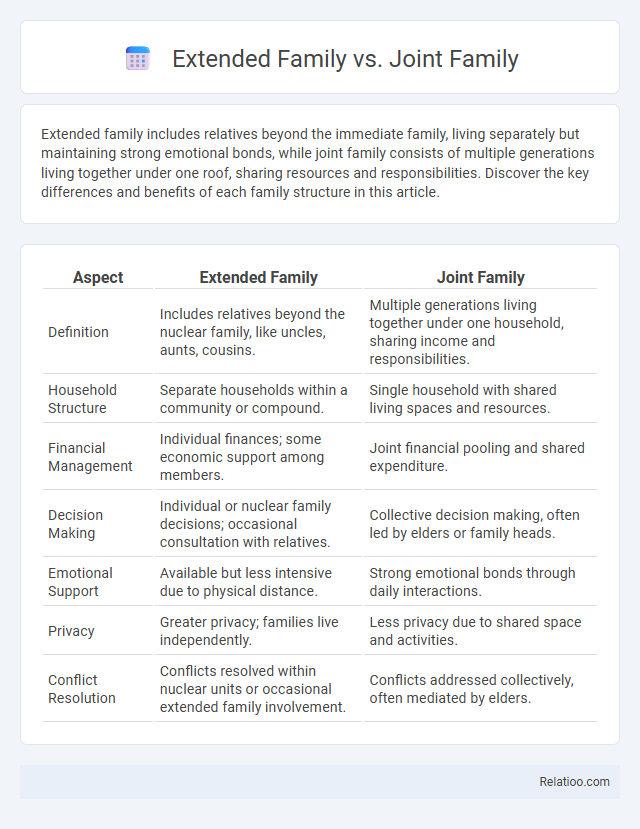Extended family includes relatives beyond the immediate family, living separately but maintaining strong emotional bonds, while joint family consists of multiple generations living together under one roof, sharing resources and responsibilities. Discover the key differences and benefits of each family structure in this article.
Table of Comparison
| Aspect | Extended Family | Joint Family |
|---|---|---|
| Definition | Includes relatives beyond the nuclear family, like uncles, aunts, cousins. | Multiple generations living together under one household, sharing income and responsibilities. |
| Household Structure | Separate households within a community or compound. | Single household with shared living spaces and resources. |
| Financial Management | Individual finances; some economic support among members. | Joint financial pooling and shared expenditure. |
| Decision Making | Individual or nuclear family decisions; occasional consultation with relatives. | Collective decision making, often led by elders or family heads. |
| Emotional Support | Available but less intensive due to physical distance. | Strong emotional bonds through daily interactions. |
| Privacy | Greater privacy; families live independently. | Less privacy due to shared space and activities. |
| Conflict Resolution | Conflicts resolved within nuclear units or occasional extended family involvement. | Conflicts addressed collectively, often mediated by elders. |
Introduction to Extended and Joint Families
Extended families consist of multiple generations living together or in close proximity, sharing resources and responsibilities beyond the nuclear unit. Joint families are a specific form of extended family common in South Asian cultures, where several related nuclear families live under one roof, maintaining collective decision-making and property. Both family structures emphasize strong interpersonal bonds, economic cooperation, and social support systems.
Defining Extended Family Structure
Extended family structure includes multiple generations living together or in close proximity, often encompassing grandparents, aunts, uncles, and cousins beyond the nuclear and joint family units. Unlike joint families, which primarily consist of siblings and their dependents living under one roof, extended families maintain broader kinship ties with more dispersed household patterns. This arrangement supports shared responsibilities, resource pooling, and cultural continuity across a wider familial network.
Understanding Joint Family System
The joint family system is a traditional living arrangement where multiple generations, including parents, children, grandparents, uncles, aunts, and cousins, reside together under one roof, sharing resources and responsibilities. Unlike the extended family, which may live separately but maintain close ties, the joint family emphasizes collective decision-making, economic cooperation, and social unity. This structure fosters strong familial bonds, supports childcare and eldercare, and sustains cultural and familial traditions through shared daily interactions.
Key Differences Between Extended and Joint Families
Extended families consist of multiple generations or relatives living separately but maintaining close relationships, while joint families share a common household including grandparents, parents, and children living together. Key differences include the physical living arrangements where joint families live under one roof promoting collective decision-making, whereas extended families often live in separate homes but maintain strong emotional bonds. Your choice depends on cultural values and personal preferences regarding proximity and familial interaction.
Cultural Significance and Traditions
Extended families encompass multiple generations living separately but maintain strong cultural ties through shared traditions and rituals, emphasizing heritage preservation. Joint families, common in South Asian cultures, feature multiple generations cohabiting under one roof, fostering collective responsibility, mutual support, and the continuation of family customs. Both family structures play integral roles in sustaining cultural identities, social cohesion, and intergenerational knowledge transfer within their respective communities.
Social Roles and Responsibilities
Extended family structures encompass multiple generations living apart but maintaining close social ties, where your social roles involve supporting relatives emotionally and financially beyond the immediate household. Joint families share a common residence, with collective responsibilities such as childcare, household chores, and decision-making distributed among members, reinforcing strong social cohesion. Both family types emphasize shared duties, but joint families have more integrated daily interactions, while extended families rely on periodic support and social obligations.
Economic Aspects and Financial Management
Extended family systems often involve shared financial responsibilities and pooled resources among multiple generations, creating a robust economic support network for members. Joint families typically manage finances collectively under one household, optimizing expenses and enabling bulk savings but sometimes limiting individual financial autonomy. Your approach to economic aspects varies significantly between these family structures, impacting budgeting, investment decisions, and wealth distribution within the family unit.
Emotional Support and Family Bonding
Extended families provide strong emotional support through close-knit relationships across multiple generations, fostering deep family bonding and shared responsibilities. Joint families emphasize collective living under one roof, promoting daily interactions and unified decision-making that strengthen emotional ties and interdependence. In contrast, nuclear families typically have fewer members, which may limit the scope of emotional support and bonding compared to extended or joint family systems.
Challenges and Conflicts in Each Family Type
Challenges in joint families often stem from shared responsibilities and limited privacy, leading to frequent conflicts over decision-making and resource allocation. Extended families face complications in maintaining cohesive relationships due to geographic dispersion and differing generational values, which can create emotional distance and misunderstandings. Your ability to navigate these conflicts relies on clear communication and respect for individual boundaries to foster harmony in any family structure.
Choosing the Right Family System in Modern Society
Choosing the right family system in modern society depends on your priorities for support, privacy, and cultural values. Extended families, often including relatives beyond the nuclear unit, provide a robust support network and shared responsibilities, while joint families emphasize collective living under one roof, promoting unity but sometimes limiting personal space. Evaluating your lifestyle needs and social environment helps determine whether the extended, joint, or nuclear family structure best aligns with your goals and well-being.

Infographic: Extended Family vs Joint Family
 relatioo.com
relatioo.com